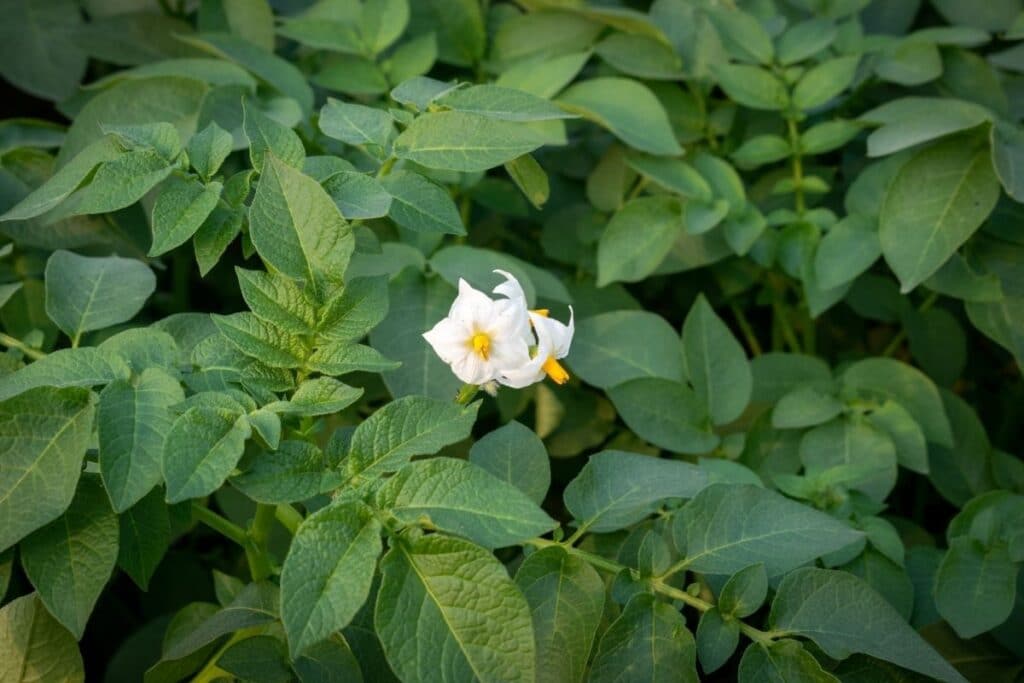Who doesn’t love to eat potatoes? Whether you’re enjoying some potato slices fried in olive oil or a big bowl of mashed potatoes, there’s so much to love about delicious ‘taters.
Some people may not realize that potatoes can flower and even produce fruit. We generally only think about the part of the plant we eat which comes from underground stems that produce tubers.
- Why Do Potatoes Flower?
- Are Potato Flowers Edible?
- What Do Potato Flowers Look Like?
- Should Potato Flowers Be Removed?
- Do Potato Flowers Always Bloom?
- Can You Use Potato Flowers to Judge Harvest?
- How Long Do Potato Plants Take To Flower?
- What Are The Fruits That Come From Potatoes Like?
- What Else Can These Flowers Indicate?
- Can You Eat Potato Plant Flowers?
- Flowering Potatoes Are Pretty, But Not Edible
These tubers are the potatoes that we know and love. So what use are the flowers if the edible food grows underground?
Potatoes are a member of the Nightshade family along with tomatoes, eggplants, and peppers. Most members of this family produce flowers that, when pollinated, make room for incoming fruits.
Although the potato plant does have flowers that turn into fruit, the fruit is poisonous and should be avoided. In the process of growing and eating potatoes, these flowers don’t serve many purposes.
Let’s take a closer look at everything you need to know about the flowers on potatoes!
Why Do Potatoes Flower?
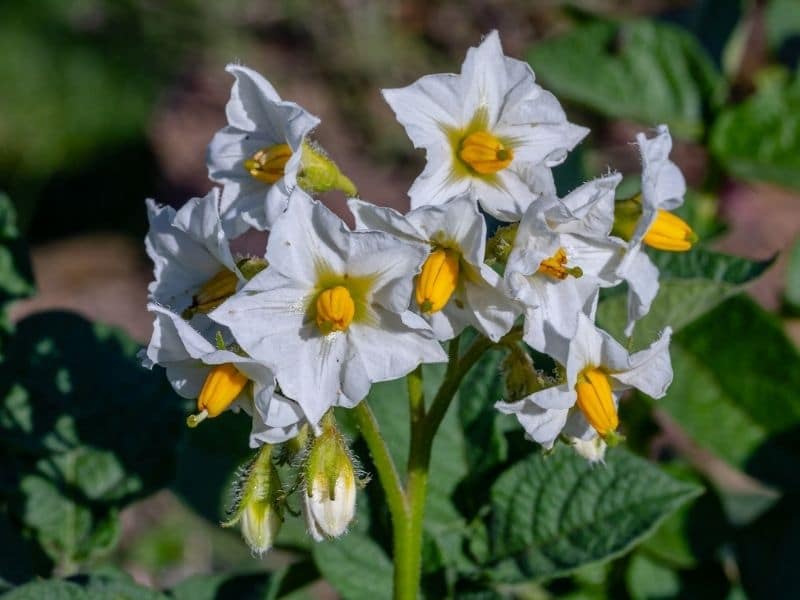
To understand why potatoes flower, you first have to understand that potato plants have the capacity to produce fruit in addition to the potatoes we eat, which are considered vegetables. To produce fruit, a plant first needs to flower.
Fruit can form when the flower of a fruit plant is pollinated—whether that be self-pollination or pollen from another plant.
Once the flower is pollinated, the fertilized ovule of the flower can start to grow and eventually become a full-sized fruit!
As mentioned previously, the fruit that potatoes produce is poisonous, and it should not be eaten for any reason.
Although we happily eat fruit produced by other plants (in most cases), potato fruit is not produced for our enjoyment—it simply houses the seeds necessary for the growth of new plants—it’s how they multiply themselves!
So even though we cannot eat the fruit produced by potatoes, it serves the crucial function of housing seeds that can be used to grow more plants in the future. But wait—don’t we plant potatoes from seed potatoes and not the seeds that come from the fruit?
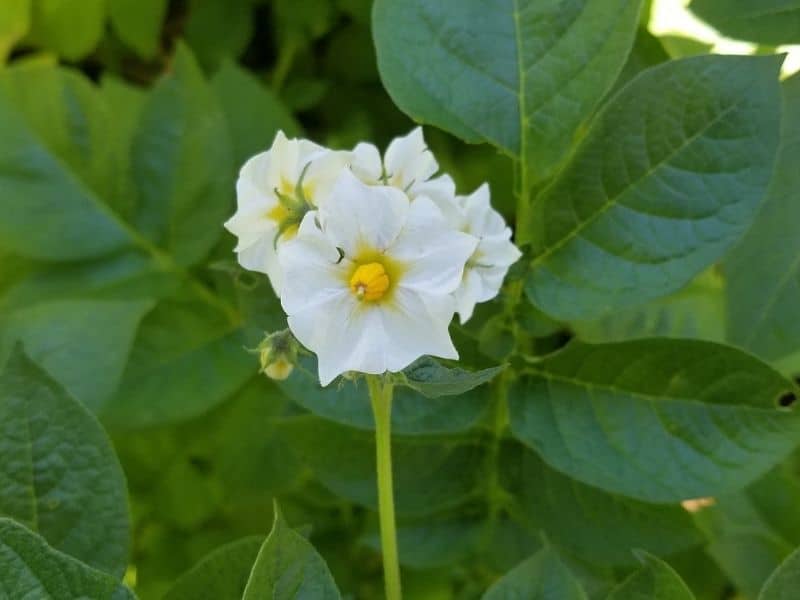
Most gardeners who grow potatoes will use seed potatoes, or sections of larger potatoes from the previous year.
Growing a potato plant from a seed potato will produce an identical clone of the former plant, meaning you can get the same variety of potatoes year after year.
On the other hand, growing potatoes from a seed that comes from its own fruit will not produce an identical plant because the fruit seed was created via the contribution of pollen from another plant, creating a new hybrid—kind of like the formation of humans and other sexually reproducing organisms.
Growing potatoes from these seeds will also take longer to develop than if you planted a seed potato.
In most growing zones, you would need to start your potato seeds—the ones that come directly from the fruit—inside in late winter before transplanting them outdoors in order to get potatoes that are fully developed before frost hits.
Are Potato Flowers Edible?
Both the flowers and the fruits that come from these flowers are poisonous and should not be eaten.
All parts of the potato plant—except the tubers that we eat—contain solanine, a toxic chemical that causes diarrhea, abdominal pain, headaches, and other unpleasant symptoms. In extreme cases, ingesting too much solanine can even cause death.
For this reason, it is generally a good idea to leave any potato flowers that form on your plant alone and never eat them.
These flowers and the fruit can be enticing to young children, so it is important to keep them away from children and grow your potatoes somewhere they don’t play or explore.
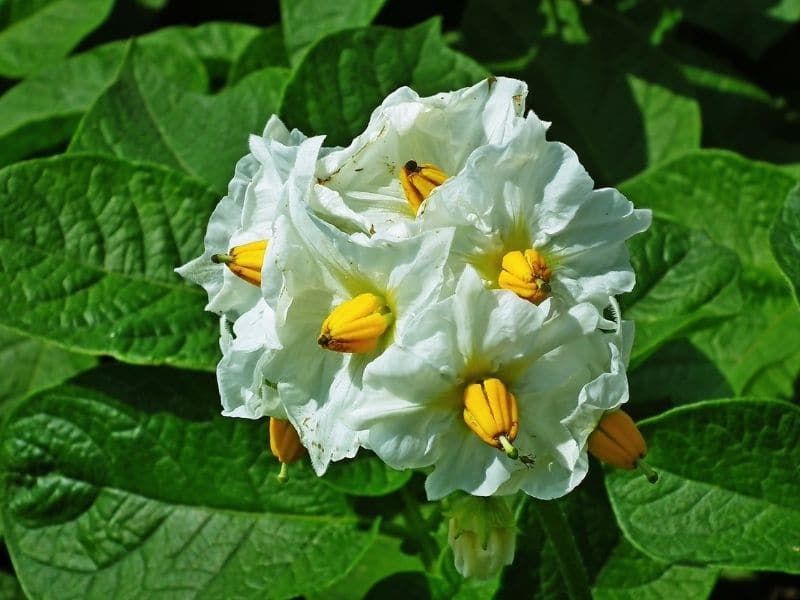
What Do Potato Flowers Look Like?
The flowers that grow on potatoes are small and sometimes form in clusters. These flowers are very similar to the flowers that tomatoes grow from, except that they come in various colors.
Potato flowers can be found in white, pink, or lavender. Color is determined by the variety of potatoes you are growing where certain varieties have specific colors.
These flowers can add a nice splash of color to your vegetable garden when in bloom, although they don’t stick around long—most people don’t grow these plants for their flowers anyway.
Should Potato Flowers Be Removed?
There is no proven reason that supports removing potato flowers from the plants once they grow. Many gardeners remove them in hopes that energy from the flower is routed towards the growth of the potatoes, but there is no evidence to support this.
If you do want to remove the flowers, this won’t harm the plant in any way and can be done at any point of the growing cycle.
One reason you may want to consider removing potato flowers is if you have kids or animals that you worry could get into the plant. No flowers mean no fruit, so you won’t have to worry about little hands and curious animals finding these poisonous fruits or flowers.
To remove flowers, you can simply pinch them off from the base with your fingers. If you’d prefer to use gardening shears, cutting near the base of the flower is the best way to avoid damaging the plant.
Cutting too much off the overall plant can result in poor yield or smaller potatoes once it comes time to harvest.
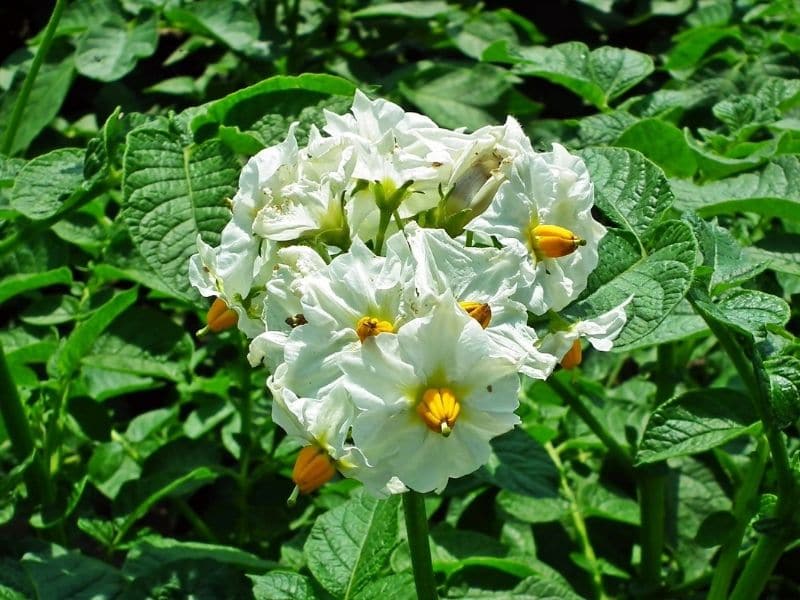
Do Potato Flowers Always Bloom?
In some cases, your potatoes may never bloom. Thankfully, this doesn’t necessarily affect the growth of the potato tubers forming underground.
In unusually warm seasons or in warmer climates, the flowers may only last for a few days, falling off before they even get a chance to bloom and be pollinated.
Since the flowers and fruit have no direct influence on the tubers, it is okay if they fall off right away or never even show up in the first place.
Potato flower blooms are generally brought on by cool and wet weather, particularly in early summer. For this reason, certain growing zones are more prone to seeing flowers than other warmer growing zones.
If you live in a warmer zone such as ten, eleven, or twelve, don’t expect the flowers to stick around long or necessarily form fruit. If you live in zones five through eight, you will likely see flowers and the fruit that forms from these flowers.
Regardless of the growing zone or whether or not your plants form flowers, your potato yield should be unaffected.
Can You Use Potato Flowers to Judge Harvest?
In some cases, you can use the flowers to judge when your potatoes are going to be ready for harvest. As a general rule, potatoes are ready to harvest approximately two to three weeks after the plants flower.
Of course, if you live in a climate where your plants never flower, or they only flower for a short period of time, you may not be able to judge the flower’s cycle.
Different potato varieties will grow at different speeds, and the flowers are heavily dependent on climate and weather, so consider checking your potatoes by hand before harvesting to ensure they are truly ready.
You can simply dig down lightly with your hands and feel the size of the potatoes to determine if they are ready to be picked.

How Long Do Potato Plants Take To Flower?
Potato plants will start to flower towards the end of their growing season as an end-of-the-season effort to release their seeds for repopulation.
Generally, you will start to see flowers 55 to 60 days after planting a seed potato in the ground. This gives the plant just enough time to flower and fruit before going dormant for the season.
The potato blossoms are only around for a short period of time while they wait to be pollinated. Once pollinated, the transformation into a fruit begins. If the flower is not pollinated after a short period of time, it will die and fall off the plant to make way for new growth.
What Are The Fruits That Come From Potatoes Like?
The fruit that forms from potato flower is similar to the fruit of a tomato plant, but it’s generally smaller and stays green instead of turning a red color. The size of this fruit is approximately the size of a cherry tomato (again, without the red color) and is round in shape.
In addition, the potato fruit supposedly has a bitter taste a deterrent for consumers. This is because potato fruit contains solenoid, a poisonous alkaloid that should never be ingested.
The potato plant fruit should not be eaten and serves no purpose to a gardener unless he or she wants to grow a new breed of potato with the seeds.
In fact, the fruit can be left alone to die and decompose on-site, or it can be removed and thrown out at any point in the growing cycle.
What Else Can These Flowers Indicate?
Another way you can put your flowers to work for you is by using them as a rough guide for knowing when to water your potato plants.
Since potatoes grow under the soil, it is difficult to determine what stage of the growing cycle they are in, which means it may be hard to decide when to increase water availability to your plants. This is important because extra water is required while the potatoes are growing in size.
If you have flowers forming on your potato plant, it is a safe bet that you also have tubers forming under the soil, meaning it is time to start increasing the amount of water that your plants are receiving to make up for the extra energy being used in growth.
Once flowers start to form, plan on adding at least one extra watering a week—unless you are getting plenty of rain—you don’t want to overwater your plants.
Can You Eat Potato Plant Flowers?
So can you eat potato plant flowers? Again, not a great idea.
There are some recipes online that say you can use potato plant flowers to make crispy potato roses. However, this is a misconception, since crispy potato roses are made from actual potatoes and not the flowers (despite how the name sounds!).
These make a mashed potato base and require you to soak potatoes in cold water before cutting potato slices with a very sharp knife, then coating them in egg yolk and cooking them in a prepared muffin tin.
While the name of potato roses sounds like it involves potato plant flowers, it really is just a fancy way of making regular potatoes.
Flowering Potatoes Are Pretty, But Not Edible
Overall, flowers from potatoes do not serve an immediate or crucial purpose to the growth of your potatoes, but they can be used as indicators for changes in the potatoes growing underground.
These flowers are poisonous but are harmless to the plant if left intact throughout growth. The fruit that grows from these flowers is also poisonous and should be left alone—unless you are extracting seeds.
For the most part, the potato grower can leave potato blossoms alone and take their indicators with a grain of salt. Simply admire their beauty when they do pop up, and don’t be alarmed if you miss them altogether.
For more flowers, check our full list of flowering plants.
References
Reference List:
Canr.msu.edu (2014). What Fruit is Growing On My Potato Plants? (Gretchen Voyle) Available at: https://www.canr.msu.edu/news/what_are_those_fruit_growing_on_my_potato_plants
Fruit.umn.edu (2018). From Flowers To Fruit (University of Minnesota) Available at: https://fruit.umn.edu/content/flowers-to-fruit
Hortnews.extension.iastate.edu (2004). Tomato-Like Fruit on Potato Plants (Iowa State University) Available at: https://hortnews.extension.iastate.edu/2004/7-2-2004/tomatopotato.html
Close
*image by depositphotos/[email protected]

